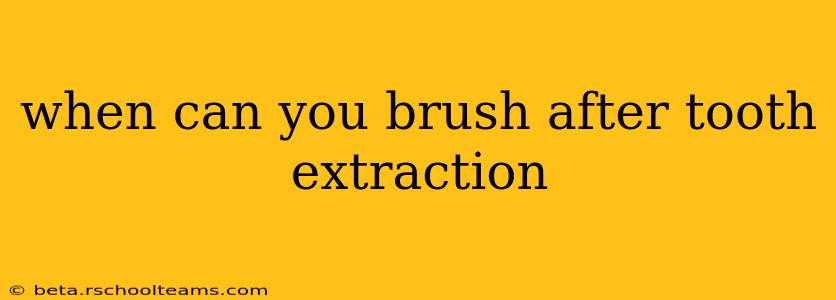Losing a tooth, whether through extraction or otherwise, is a significant event. Proper aftercare is crucial for preventing infection and ensuring a smooth recovery. One of the most frequently asked questions revolves around brushing: when is it safe to resume your regular oral hygiene routine? Let's delve into the details.
The Short Answer: You should generally wait 24 hours after a tooth extraction before brushing near the extraction site.
However, this is a simplified answer. The specifics depend on several factors, and rushing back to vigorous brushing can be detrimental to healing. Let's explore those factors and answer some common questions.
How Long Should I Wait to Brush After a Tooth Extraction?
The 24-hour waiting period is a guideline, not a rigid rule. Your dentist or oral surgeon will provide specific post-operative instructions tailored to your situation. These instructions will consider factors such as:
- The complexity of the extraction: A simple extraction will likely have a shorter recovery time compared to a more complex procedure requiring bone grafts or sutures.
- The presence of dry socket: Dry socket is a painful complication that can occur when the blood clot protecting the extraction site dislodges. Brushing too soon can increase the risk of this complication.
- Your overall health: Individuals with underlying health conditions may heal more slowly.
What Happens If I Brush Too Soon After Tooth Extraction?
Brushing too vigorously or too early can disrupt the blood clot forming in the extraction socket. This clot is vital for healing and preventing infection. Dislodging it can lead to:
- Dry socket (alveolar osteitis): This painful condition exposes the bone, leading to significant discomfort and prolonged healing time.
- Infection: An open wound is susceptible to infection, potentially delaying healing and necessitating antibiotics.
- Bleeding: Brushing can re-initiate bleeding at the extraction site.
Can I Brush My Other Teeth After a Tooth Extraction?
Yes, you can brush your other teeth as usual, but exercise caution near the extraction site. Gently brush the areas around the extraction site, avoiding direct contact with the wound itself.
What Can I Do to Keep My Mouth Clean After a Tooth Extraction?
While you should avoid brushing near the extraction site for the first 24 hours, you can still take steps to maintain oral hygiene:
- Rinse gently: Use a saltwater rinse (1/2 teaspoon of salt dissolved in 8 ounces of warm water) to gently cleanse the mouth. Do this several times a day, but avoid forceful rinsing that could dislodge the blood clot.
- Focus on other areas: Brush and floss your other teeth carefully.
- Follow your dentist's instructions: Adhere strictly to the post-operative care instructions provided by your dentist or oral surgeon.
What Kind of Toothbrush Should I Use After Tooth Extraction?
After the initial 24-hour period, use a soft-bristled toothbrush to avoid irritating the healing tissue. Gentle brushing is key throughout the healing process.
When Can I Start Flossing After Tooth Extraction?
Similar to brushing, avoid flossing near the extraction site for at least 24 hours. Once the initial healing period has passed, you can gently floss around the area, taking care not to disturb the healing tissue. Your dentist can provide specific guidance.
How Long Does It Take to Fully Recover From a Tooth Extraction?
Complete healing varies depending on individual factors, but most people see significant healing within a few weeks. The extraction site will likely still be sensitive for some time. Full bone regeneration may take several months.
Remember: Always follow your dentist's or oral surgeon's specific post-operative instructions. They can provide the most accurate and personalized advice regarding when and how to brush after your tooth extraction. This information is for general knowledge and should not replace professional dental advice.
